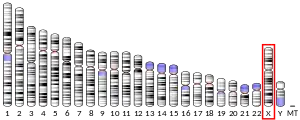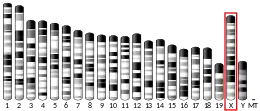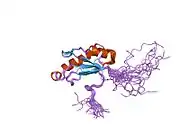| HTATSF1 | |||||||||||||||||||||||||||||||||||||||||||||||||||
|---|---|---|---|---|---|---|---|---|---|---|---|---|---|---|---|---|---|---|---|---|---|---|---|---|---|---|---|---|---|---|---|---|---|---|---|---|---|---|---|---|---|---|---|---|---|---|---|---|---|---|---|
 | |||||||||||||||||||||||||||||||||||||||||||||||||||
| |||||||||||||||||||||||||||||||||||||||||||||||||||
| Identifiers | |||||||||||||||||||||||||||||||||||||||||||||||||||
| Aliases | HTATSF1, TAT-SF1, TATSF1, dJ196E23.2, HIV-1 Tat specific factor 1 | ||||||||||||||||||||||||||||||||||||||||||||||||||
| External IDs | OMIM: 300346 MGI: 1919709 HomoloGene: 40950 GeneCards: HTATSF1 | ||||||||||||||||||||||||||||||||||||||||||||||||||
| |||||||||||||||||||||||||||||||||||||||||||||||||||
| |||||||||||||||||||||||||||||||||||||||||||||||||||
| |||||||||||||||||||||||||||||||||||||||||||||||||||
| |||||||||||||||||||||||||||||||||||||||||||||||||||
| |||||||||||||||||||||||||||||||||||||||||||||||||||
| Wikidata | |||||||||||||||||||||||||||||||||||||||||||||||||||
| |||||||||||||||||||||||||||||||||||||||||||||||||||
HIV Tat-specific factor 1 is a protein that in humans is encoded by the HTATSF1 gene.[5][6]
Function
Whereas most DNA sequence-specific transcription factors increase the rate of initiation and interact with enhancer or promoter DNA, human immunodeficiency virus-1 (HIV-1) Tat predominantly stimulates elongation and interacts with the trans-acting responsive (TAR) RNA element. Tat is essential for HIV replication.[6]
HTATSF1 has also been shown to be involved in intron retention, and is associated with splicing of mRNAs that encode ribosomal proteins.[7] It is also associated with a naïve pluripotent state, although the relationship is complex and is strongly affected by other pluripotency factors such as Nanog and KLF2.[7]
Interactions
HTATSF1 has been shown to interact with SUPT5H[8] and GTF2F2.[8]
References
- 1 2 3 GRCh38: Ensembl release 89: ENSG00000102241 - Ensembl, May 2017
- 1 2 3 GRCm38: Ensembl release 89: ENSMUSG00000067873 - Ensembl, May 2017
- ↑ "Human PubMed Reference:". National Center for Biotechnology Information, U.S. National Library of Medicine.
- ↑ "Mouse PubMed Reference:". National Center for Biotechnology Information, U.S. National Library of Medicine.
- ↑ Zhou Q, Sharp PA (November 1996). "Tat-SF1: cofactor for stimulation of transcriptional elongation by HIV-1 Tat". Science. 274 (5287): 605–10. Bibcode:1996Sci...274..605Z. doi:10.1126/science.274.5287.605. PMID 8849451. S2CID 13266489.
- 1 2 "Entrez Gene: HTATSF1 HIV-1 Tat specific factor 1".
- 1 2 Corsini NS, Peer AM, Moeseneder P, Roiuk M, Burkard TR, Theussl H, Moll I, Knoblich JA (April 2018). "Coordinated Control of mRNA and rRNA Processing Controls Embryonic Stem Cell Pluripotency and Differentiation". Cell Stem Cell. 22 (4): 543–558.e12. doi:10.1016/j.stem.2018.03.002. ISSN 1934-5909. PMID 29625069.
- 1 2 Kim JB, Yamaguchi Y, Wada T, Handa H, Sharp P A (September 1999). "Tat-SF1 protein associates with RAP30 and human SPT5 proteins". Mol. Cell. Biol. 19 (9): 5960–8. doi:10.1128/mcb.19.9.5960. ISSN 0270-7306. PMC 84462. PMID 10454543.
Further reading
- Maruyama K, Sugano S (1994). "Oligo-capping: a simple method to replace the cap structure of eukaryotic mRNAs with oligoribonucleotides". Gene. 138 (1–2): 171–4. doi:10.1016/0378-1119(94)90802-8. PMID 8125298.
- Suzuki Y, Yoshitomo-Nakagawa K, Maruyama K, et al. (1997). "Construction and characterization of a full length-enriched and a 5'-end-enriched cDNA library". Gene. 200 (1–2): 149–56. doi:10.1016/S0378-1119(97)00411-3. PMID 9373149.
- Zhou Q, Chen D, Pierstorff E, Luo K (1998). "Transcription elongation factor P-TEFb mediates Tat activation of HIV-1 transcription at multiple stages". EMBO J. 17 (13): 3681–91. doi:10.1093/emboj/17.13.3681. PMC 1170704. PMID 9649438.
- Yan D, Perriman R, Igel H, et al. (1998). "CUS2, a yeast homolog of human Tat-SF1, rescues function of misfolded U2 through an unusual RNA recognition motif". Mol. Cell. Biol. 18 (9): 5000–9. doi:10.1128/MCB.18.9.5000. PMC 109085. PMID 9710584.
- Li XY, Green MR (1998). "The HIV-1 Tat cellular coactivator Tat-SF1 is a general transcription elongation factor". Genes Dev. 12 (19): 2992–6. doi:10.1101/gad.12.19.2992. PMC 317190. PMID 9765201.
- Parada CA, Roeder RG (1999). "A novel RNA polymerase II-containing complex potentiates Tat-enhanced HIV-1 transcription". EMBO J. 18 (13): 3688–701. doi:10.1093/emboj/18.13.3688. PMC 1171446. PMID 10393184.
- Kim JB, Yamaguchi Y, Wada T, et al. (1999). "Tat-SF1 protein associates with RAP30 and human SPT5 proteins". Mol. Cell. Biol. 19 (9): 5960–8. doi:10.1128/mcb.19.9.5960. PMC 84462. PMID 10454543.
- Fong YW, Zhou Q (2000). "Relief of two built-In autoinhibitory mechanisms in P-TEFb is required for assembly of a multicomponent transcription elongation complex at the human immunodeficiency virus type 1 promoter". Mol. Cell. Biol. 20 (16): 5897–907. doi:10.1128/MCB.20.16.5897-5907.2000. PMC 86067. PMID 10913173.
- Suñé C, Goldstrohm AC, Peng J, et al. (2000). "An in vitro transcription system that recapitulates equine infectious anemia virus tat-mediated inhibition of human immunodeficiency virus type 1 Tat activity demonstrates a role for positive transcription elongation factor b and associated proteins in the mechanism of Tat activation". Virology. 274 (2): 356–66. doi:10.1006/viro.2000.0480. PMID 10964778.
- Simmons A, Aluvihare V, McMichael A (2001). "Nef triggers a transcriptional program in T cells imitating single-signal T cell activation and inducing HIV virulence mediators". Immunity. 14 (6): 763–77. doi:10.1016/S1074-7613(01)00158-3. PMID 11420046.
- Fong YW, Zhou Q (2002). "Stimulatory effect of splicing factors on transcriptional elongation". Nature. 414 (6866): 929–33. doi:10.1038/414929a. PMID 11780068. S2CID 1518837.
- Strausberg RL, Feingold EA, Grouse LH, et al. (2003). "Generation and initial analysis of more than 15,000 full-length human and mouse cDNA sequences". Proc. Natl. Acad. Sci. U.S.A. 99 (26): 16899–903. Bibcode:2002PNAS...9916899M. doi:10.1073/pnas.242603899. PMC 139241. PMID 12477932.
- Zhou BY, He JJ (2004). "Proliferation inhibition of astrocytes, neurons, and non-glial cells by intracellularly expressed human immunodeficiency virus type 1 (HIV-1) Tat protein". Neurosci. Lett. 359 (3): 155–8. doi:10.1016/j.neulet.2004.02.012. PMID 15050687. S2CID 3048557.
- Ballif BA, Villén J, Beausoleil SA, et al. (2005). "Phosphoproteomic analysis of the developing mouse brain". Mol. Cell. Proteomics. 3 (11): 1093–101. doi:10.1074/mcp.M400085-MCP200. PMID 15345747.
- Smith MJ, Kulkarni S, Pawson T (2004). "FF domains of CA150 bind transcription and splicing factors through multiple weak interactions". Mol. Cell. Biol. 24 (21): 9274–85. doi:10.1128/MCB.24.21.9274-9285.2004. PMC 522232. PMID 15485897.
- Gerhard DS, Wagner L, Feingold EA, et al. (2004). "The status, quality, and expansion of the NIH full-length cDNA project: the Mammalian Gene Collection (MGC)". Genome Res. 14 (10B): 2121–7. doi:10.1101/gr.2596504. PMC 528928. PMID 15489334.
- Zhou M, Deng L, Lacoste V, et al. (2004). "Coordination of transcription factor phosphorylation and histone methylation by the P-TEFb kinase during human immunodeficiency virus type 1 transcription". J. Virol. 78 (24): 13522–33. doi:10.1128/JVI.78.24.13522-13533.2004. PMC 533906. PMID 15564463.
- Ross MT, Grafham DV, Coffey AJ, et al. (2005). "The DNA sequence of the human X chromosome". Nature. 434 (7031): 325–37. Bibcode:2005Natur.434..325R. doi:10.1038/nature03440. PMC 2665286. PMID 15772651.
- Missé D, Gajardo J, Oblet C, et al. (2005). "Soluble HIV-1 gp120 enhances HIV-1 replication in non-dividing CD4+ T cells, mediated via cell signaling and Tat cofactor overexpression". AIDS. 19 (9): 897–905. doi:10.1097/01.aids.0000171403.07995.92. PMID 15905670. S2CID 23688259.






